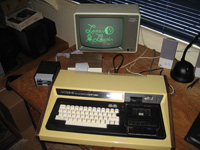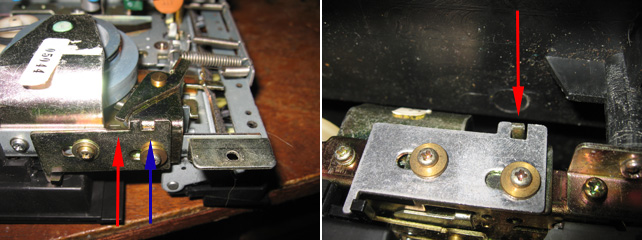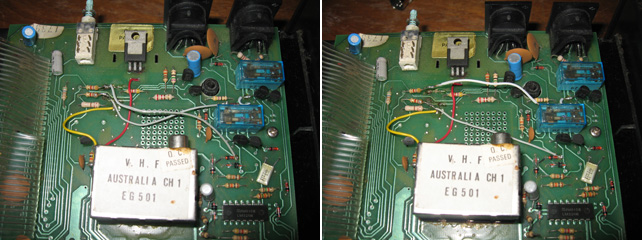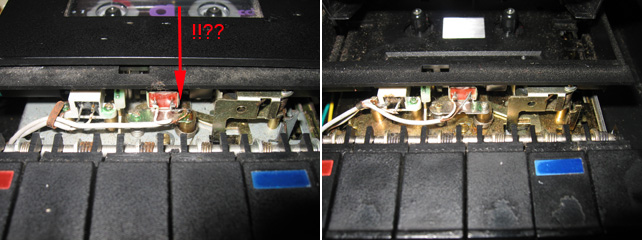Restoring a System 80 / Video Genie/ PMC-80 Part 2: Fixing a cassette deck problem
 Introduction
Introduction
This is the second step in a restoration process that started with a faulty 16k System 80. It was going to be a parts machine but I just had to fix it. The first task was to repair a video fault. Next is a cassette deck problem, which is the topic of this article.
There were five problems with the cassette deck. I managed to fix two in this session. I thought I had fixed a third one but that proved to be wishful thinking as a later article describes. The two remaining problems are minor.
Problem one - Stop means Eject!
To stop a tape on the System 80 (and on many cassette decks) you normally push the stop/eject button. This stops the motor and pulls back the heads. To eject the tape you push this button down further. The lid then pops up and the cassette is spat out. Not so in this particular cassette deck. Here, everything happened in one go. Pressing the stop button didn't just stop the tape, it also popped it out! That's not suppose to happen!
The cassette mechanism, with all those levers and springs, can be a little complicated. However, having other System 80s meant I could compare good tape decks directly with this faulty one. This I did, and soon found the problem. A lever connected to the stop/eject button was slotted into the wrong place (figure 1).

Figure 1. Position of the stop/eject latch on the faulty unit (left) and a working cassette deck. The blue arrow shows where it should be
After I re-slotted this lever to where it should be the cassette deck stopped play on a single press, then ejected the cassette with a harder press. It was back to normal behaviour!
Problem two - Restoring the correct cassette signal lines
The System 80 comes with two cassette ports named in BASIC by the suffixes #-1 and #-2. Number one is the inbuilt cassette deck and number two refers to an external one, plugged in via a socket at the back. The System 80 built-in cassette deck is fairly cheap and was not known for its reliability. Also the cassette belt would stretch and perish over time. Although the external cassette could be activated easily to load a BASIC program the same could not be said of programs consisting of machine language code. Binary code programs loaded straight in into memory used the SYSTEM command. This command only recognised the inbuilt cassette #-1. It was common therefore for owners to wire their machines so cassette #-1 was the external deck and cassette #-2 the internal one.
This machine had such a modification. However contrary to the usual practice, no toggle switch had been installed. Rather it was simply a reversal of the cassette signals. While this modification was useful at the time, stand-alone cassette recorders suitable for data recordings via the external port are not so readily available today. Also, I found that when software with sound routines were run the cassette relays clicked and vibrated. This shouldn't happen so I felt there was something screwy with the circuitry. Consequently I decided to restore the machine back to the original configuration. If the inbuilt cassette deck worked, it would be closer to the "classic" configuration and would allow a user to load all software using it.
Inspecting the machine revealed the wires used to switch cassette decks. As the tracks were cut in the board (figure 2), rather than re-insert the ends of the resistors I simply swapped the wires around so the jumpers led the signal to where the tracks would have originally carried them anyway (figure 3).

Figure 2. Track cutting and some ugly solder residue left by the previous owner(s) during this modification

Figure 3. Original modification on left, my restoration rewiring on right
After doing this I found that a call to cassette #-2 loaded a tape from the external cassette and a call to #-1 activated the internal cassette deck. However, the tape deck seemed to only record. There was no signal on playback. I wasn't out of the woods yet.
Problem three - No playback signal
I'm sure this problem was due to the cassette deck itself rather than the video board, so I swapped the cassette player into one of my other System 80s. The problem persisted showing the issue was definitely with the player itself. I inspected all the wiring carefully and found something! In the faulty unit, one wire going to the playback head was also solidly soldered to the screw holding the head mechanism in place?? It didn't look like it was suppose to be there so I checked the working deck. Sure enough, none of the two wires were soldered this way (figure 4).

Figure 4. One playback lead soldered to an anchoring screw on the faulty unit (left) but not in the working unit (right)
After desoldering the wire from the screw a playback signal was in evidence. The cassette recorder was now fixed.
Fixed. Well hopefully?
I then gave the cassette player a good workout. Partway through this is suddenly stopped working again?? There was no signal on playback yet record was fine. This made me wonder if the fix above was actually no fix at all but something else entirely. I dragged out the cassette deck again and had a thorough look. There was no evidence of loose wires...all solder joints seem to be ok...I could find nothing!?
I reinserted the deck and suddenly it was working again. It's been working ever since and I've been testing it extensively. My conclusion is the problem may have been a dry solder joint somewhere. From handling the unit, this has suddenly connected. It seems to work now but not knowing exactly what the matter was, I'm not sure if it will remain working indefinitely. (Note: And in fact it didn't! See article four in this series)
Two minor issue remain which I'm not able to do much about. First, the lid over the cassette has a broken hinge on one side. This means the lid doesn't pop open evenly but extracting or inserting a cassette is no problem. Second, the motor is too weak (or more likely, the belt is too loose and worn) to rewind long tapes. Flipping the tape over and fast forwarding in order to rewind seems to work.
Reflections
The cassette deck had obviously been messed with for some reason or another. Everything appears to now be the same as my other working decks so it has been restored to its original state. It's come a long way. From a non-working "garbage screen" machine this unit is now a fully functional 16k System 80. However there is still the cosmetic issue of the cracked and damaged case. This repair (among other improvements) is detailed in part three.
Tez
6th July, 2010
Updated 29th July, 2010
| Tweet |